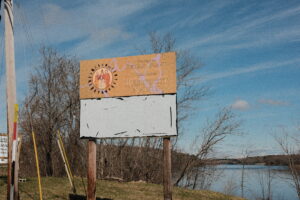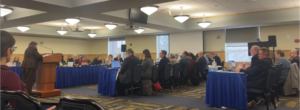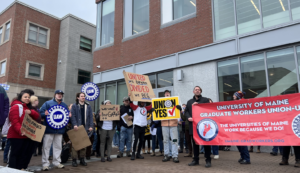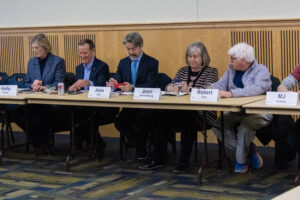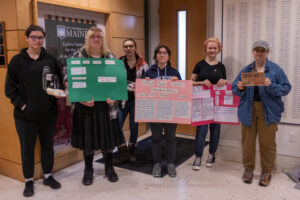MILFORD, ME — In an unassuming neighborhood off of Bradley Road, six giant work trucks, each filled with around 10,000 juvenile Atlantic salmon, park at the edge of the Penobscot River in preparation to introduce these fish to their new home. These trucks are a part of a fish stocking event conducted by the United States Fish and Wildlife Service (USFWS). The goal is to reintroduce the endangered Atlantic salmon back into Maine rivers.
Maine Campus Media had the opportunity to observe this stocking event in action. During the event, biologists for the USFWS attached a hose from the tank of the truck and inserted the other end into the Penobscot River. Over the span of around 20 minutes, 20,390 (as estimated by assistant project leader Catherine Johnston) gushed out of the “fish hose.” Bald eagles circled overhead as if they knew a new dish was being served for lunch, but the tiny salmon seemed to not be bothered as they acclimated nicely to their new environment. These fish are currently in their smoltification stage of life. This is the most important stage of a salmon’s life as they begin to metamorphose and obtain the ability to migrate from freshwater to seawater. The fish introduced from the hatchery to the Penobscot River will imprint on their new surroundings. When the time comes they will eventually migrate downstream to the ocean, where they will freely swim and hunt until they grow to full-size adults, and then make their way back upstream to spawn again and introduce a whole new generation of salmon into the Maine wilderness.
According to Catherine Johnston, throughout the stocking season the USFWS will be releasing around 643,000 fish into the Penobscot and Piscataquis rivers.

In addition to viewing the stocking event, The Maine Campus had the opportunity to talk to Catherine Johnston and Oliver Cox, hatchery manager of the USFWS Green Lake Fish Hatchery.
Q: What is the USFWS National Fish Hatchery?
A: The Green Lake National Fish Hatchery (GLNFH) is part of the U.S. Fish and Wildlife Service (USFWS), which is a federal agency whose mission is to work with others to conserve, protect, and enhance fish, wildlife, plants and their habitats for the continuing benefit of the American people.
The USFWS has over 70 national fish hatcheries across the country that raise aquatic wildlife to recover federally listed threatened or endangered species, improve sustainable recreational fishing, support fisheries that have been impacted by a federal dam project, and prevent at-risk species from becoming endangered.
There are two USFWS national fish hatcheries located in Maine that both focus solely on the recovery of Atlantic salmon in the Gulf of Maine Distinct Population Segment. Craig Brook NFH (in Orland) and Green Lake NFH (in Ellsworth) culture Atlantic salmon in an effort to preserve the genetic diversity of the populations and prevent extinction.
Craig Brook manages adult broodstocks of Atlantic salmon that originate from seven distinct rivers in Maine (the Penobscot, Machias, Narraguagus, Sheepscot, East Machias, Dennys and Pleasant rivers). They produce over 3 million eggs annually that they raise and then stock out, or transfer to Green Lake NFH and other partners to do the same. The bulk of Green Lake NFH’s fish production is for the Penobscot River — Green Lake NFH receives the Penobscot River origin eggs from Craig Brook NFH and rears them to produce 850,000 juvenile fish annually to stock into the Penobscot River.
Q: Why is the USFWS NFH raising and releasing salmon?
A: The state of Maine is home to the last remaining natural populations of Atlantic salmon in the United States. Prior to the late 1800s, Atlantic salmon used to be found in most coastal rivers northeast of New York’s Hudson River and numbered in the hundreds of thousands. Stressors like dams, pollution, and overfishing caused the numbers to deplete and Atlantic salmon were eventually extirpated in the southern part of the range. Commercial fishing was prohibited in 1948 but populations remained low and the species was listed as endangered under the Endangered Species Act in 2000. The USFWS National Fish Hatcheries in Maine raise and stock Atlantic salmon to work towards their recovery. Federal, state, and tribal partners across Maine are also working towards the species’ recovery by improving habitat, removing fish passage barriers, doing research, and other actions.
Q: How long does it take to raise salmon before release?
A: It takes about 18 months to go from an egg to the smolt that the Green Lake NFH releases each spring. Spawning occurs in November and December each year to create eggs. The eggs develop and eventually hatch into fry in late March and continue to grow through spring, summer, and fall. They are held on station and released in spring to coincide with when smolts produced in the wild will be migrating out to the ocean.

Q: Are all salmon raised at NFH released?
A: Yes, all of the salmon raised at the hatcheries are released at various life stages (eggs, fry, parr, smolts, and adults). The hatcheries work with partners to determine stocking plans, e.g., what life stage to release, how many, and where.
Q: Why is it important that there are salmon in Maine’s rivers?
A: Atlantic salmon and salmon rivers hold a very important cultural and historical importance for Maine’s tribal people. Atlantic salmon also used to provide important recreational and commercial fishing opportunities in Maine and New England. The decline in Atlantic salmon populations signifies the poor impact that humans had on the species and its habitat. But, the poor state of the species is also an opportunity for people to come together and work to rectify this. Many improvements have already been made like water quality improvements, dam removals, and habitat restoration projects. There is still a long way to go, but each step towards recovery of Atlantic salmon in Maine rivers will also support the health and sustainability of other fish species and the rivers and communities they are found in.
Q: How many salmon are raised each year?
A: Green Lake NFH produces about 200,000 Atlantic salmon parr and 650,000 smolts annually. We also maintain a domestic brood line of Penobscot origin Atlantic salmon to produce about 1.3 million eyed eggs annually that we transfer to partners for egg planting and outreach.
Q: How does the program choose where salmon are released?
A: There are numerous stocking locations that the hatcheries have used depending on life stage, river of origin, and other factors. But the most frequently used stocking location for Green Lake NFH’s smolts is Sandy Point in Milford. Fish tagging studies (conducted by researchers at the University of Maine and other partners) have been crucial to building an understanding of how Atlantic salmon move through barriers in the system like dams and culverts. Based on the results of these tagging studies, we know that stocking the smolts at Milford, below the lowest dam on the Penobscot River, translates to the highest number of smolts reaching the ocean.
Q: Does the program track the salmon that are released?
A: Yes. There are few ways we can track fish that are released. We can add a visual tag or mark (like a clipped fin or colorful tag on the outside of the fish) so that, if they are captured, they can be identified. University of Maine and NOAA researchers often collaborate with the hatchery to complete the tagging and tracking of salmon. Researchers also often implant acoustic tags into a subset of fish so that their movements can be tracked. As a tagged smolt swims downstream in the river, their movements are documented by receivers that are kept in the river to listen for and record the acoustic tags in fish as they swim by. Researchers have collected a lot of valuable data using this method that has helped inform the stocking strategy.
Q: Is it known what the salmon that are released today will do?
A: We release our smolts to coincide with the wild smolt migration window. Following the release of our fish, they begin their migration out to the ocean. Most of the Atlantic salmon migrating from Maine rivers spend two years in the ocean. While at sea, they migrate to the North Atlantic Ocean off West Greenland and then return as mature adults to their river of origin. When adult Atlantic salmon return to the Penobscot River, they eventually arrive at the Milford Dam where there is a facility to either pass fish over the dam or hold them. Each year, Craig Brook National Fish Hatchery receives some of these returned adults and uses them as broodstock to create more fish for stocking.
Q: What is the benefit of releasing grown salmon versus just releasing fertilized eggs?
A: Multiple life stages of Atlantic salmon are released by the hatcheries into the wild over the year. Eggs are planted into healthy stream habitats in the winter. Small juvenile fish (fry and parr) are released in the spring (fry) and early fall (parr). And smolts are released in the spring. When earlier life stages of fish are stocked, that allows the fish to have a more natural life history, more like their wild cousins. However, there is much higher mortality for smaller life stages, so that is a tradeoff. Stocking multiple life stages helps to address that tradeoff.
Q: Has there been a strong indication in the data that salmon release has positively helped the population?
A: Prior to the human-caused population declines, an estimated 75,000 to 100,000 adult Atlantic salmon returned to the Penobscot River each year. Current return numbers are still a small fraction of that. In 2022, about 1,320 adult salmon returned to the Penobscot River. That number is the second highest in the last 10 years. In the last 10 years, about 92% of the adult fish that returned are of hatchery origin. Hatchery origin fish significantly contribute to adult returns in other Maine rivers too. Biologists and managers track the number of adult returns and number of wild versus hatchery origin adults annually as important metrics of recovery progress.
Q: Are there any concerns with low genetic variety being released into the wild?
A: USFWS Geneticists oversee the genetic management of the hatcheries and we have protocols aiming to maintain genetic diversity of Atlantic salmon that we raise. We take fin clips that allow the geneticists to individually identify each adult fish that we use as brood stock. We use a software program during spawning that ensures that the most genetically diverse match is made in each pairing to create eggs.

Q: What could the citizen’s of Maine who want to support Atlantic salmon do to help the population or this program?
A: Learn more about the species and teach others (neighbors, classmates, family, friends) about Atlantic Salmon and why they are important. Pursue work that supports Atlantic salmon and their habitat, whether that is through science, land management, policy, education, etc. Educate yourself and others about how to minimize your contributions to carbon emissions and other climate change drivers since the recovery of Atlantic salmon and other threatened and endangered species will be challenged by climate changes.
While speaking at the stocking event, Catherine made a point of stating the majority of Atlantic salmon caught in Maine’s rivers or gulf territories most likely originated from the hatchery’s release program. Anglers are prohibited from keeping any salmon raised and released by the USFWS. Any salmon part of the program caught in Maine’s waterways must be released. However, landlocked salmon, which are Atlantic salmon that reside in lakes in the interior of the state after being trapped by receding glaciers, are open to the public to catch and keep with size and season restrictions.
Thank you to Catherine Johnston for being the contact between the Maine Campus and USFWS over the last month. To learn more information about the Craig Brook Hatchery check the Fish and Wildlife Service website: https://www.fws.gov/fish-hatchery/craig-brook
To learn more background on salmon and view a virtual tour of the hatchery click here:
https://fws.maps.arcgis.com/apps/MapJournal/index.html?appid=c8adb7a4529b437d8caeffd9991449a8






